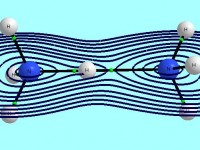
The hydrogen bond (HB) is the subject of various studies since it is important in numerous chemical, physical and biological processes.i,ii,iii,iv One of first definitions of the hydrogen bond was given by Pauling v who stated that “under certain conditions an atom of hydrogen is attracted by rather strong forces to two atoms, instead of only one, so that it may be considered to be acting as a bond between them. This is called the hydrogen bond”. This interaction may be designated as X-H…Y, where X-H is the proton donating bond while Y is the proton acceptor. Pauling pointed out that X and Y atoms should be characterized by the high electronegativity, that the Y proton acceptor should posses at least one free electron pair and that the hydrogen bond is the electrostatic interaction.
Numerous characteristics and properties of the hydrogen bond have been presented. One can mention the elongation of the X-H bond as a result of hydrogen bond formation and a concomitant decrease of the X-H stretch vibration frequency.1 This shift to lower frequencies is called a red shift and being experimentally detectable in gas, liquid and solid phase was treated as the strong evidence of the hydrogen bond formation. The X-H…Y angle close to 1800 and the H…Y distance smaller than the corresponding sum of van der Waals radii are also attributed to the hydrogen bond characteristics.vi However the subsequent studies have shown that there are interactions similar or related to the hydrogen bond which posses few of its characteristics but usually not all. The statement of the high electronegativity of X and Y atoms was contested since the C-H…O, C-H…N and C-H…S interactions were analyzed and classified as the hydrogen bonds;6,vii even the existence of the C-H…C hydrogen bond was discussed.viii
The dihydrogen bond (DHB) is the special type of the hydrogen bond where the role of the proton acceptor plays another hydrogen atom which is negatively charged.ix,x The X-H…Y interactions where the complexation leads to the shortening of the X-H bond and the accompanying increase of the X-H stretch vibration frequency (blue shift) were also analyzed.xi Thus one of the previously pointed out evidences of the existence of the hydrogen bond, the elongation of the proton donating bond, often treated as its signature was also contested.
The X-H…π interactions were analyzed and it was pointed out that they often posses characteristics of the hydrogen bond.3,xii,xiii Thus the existence of one-center proton acceptor possessing at least one free electron pair is also denied as the feature attributed to the hydrogen bond since π-electrons delocalized between two or more atoms are the proton acceptor for the X-H…π interactions.
The recent definition of Arunan and co-workers,xiv covers a diversity of interactions often classified as the hydrogen bonds. It is as follows: “the hydrogen bond is an attractive interaction between a hydrogen atom from a molecule or a molecular fragment X–H in which X is more electronegative than H, and an atom or a group of atoms in the same or a different molecule, in which there is evidence of bond formation”. This definition only slightly differs from the older one of Pimentel and McClellan xv however it contains additional lists of criteria, characteristics and footnotes which refer to systems classified in numerous studies as the hydrogen bonds. For example it is stated that “the acceptor is an electron rich region such as, but not limited to, a lone pair of Y or π-bonded pair of Y-Z”. In such a sense the X-H…π interaction is in agreement with this explanation.
New experimental techniques and theoretical methods which allow to analyze inter- and intramolecular interactions were introduced in last decades. One can mention the Quantum Theory of Atoms in Molecules (QTAIM) xvi,xvii which is a powerful tool to analyze the electron density of any molecular system and so on the properties of interactions in terms of the characteristics of the electron density. The Natural Bond Orbitals (NBO) method is another tool to analyze different interactions.xviii,xix The hydrogen bond formation, in terms of the NBO method, may be considered as the combination of two processes.xx The hyperconjugative interaction connected with the charge transfer from the Y-lone pair to the σ*(X-H) antibonding orbital. This is connected with the increase of the occupation of that orbital and it leads to the elongation of the X-H bond. The second process is connected with the increase in s-character of X hybrid orbital in the X-H bond and it is responsible for the shortening of the X-H bond. If the second effect outweighs the first one thus the blue shift of the X-H stretch vibration frequency is observed, in the other case the more common red shift hydrogen bond exists.
On a basis of NBO analyses and findings the following definition was proposed recently by Weinhold and Klein.xxiHydrogen bond: A fractional chemical bond of coordinative A–H…B Lewis acid–base type, associated with the partial intermolecular A–H…:B A:…H–B resonance (3-center/4-electron proton-sharing) commonly originating in the nB σ*AHdonor–acceptor interaction between the lone pair nBof the Lewis base and the hydride antibond σ*AHof the Lewis acid.xxii
Two kinds of interactions are analyzed here; the dihydrogen bond which was also previously considered as the X-H…σ interaction xxiii and the interaction where molecular hydrogen acts as the Lewis base, designated later as X-H…σ(H2).
i Jeffrey, G. A.; Saenger, W. Hydrogen Bonding in Biological Structures, Springer-Verlag: Berlin, 1991.
ii Scheiner, S. Hydrogen Bonding: A Theoretical Perspective, Oxford University Press: New York, 1997.


